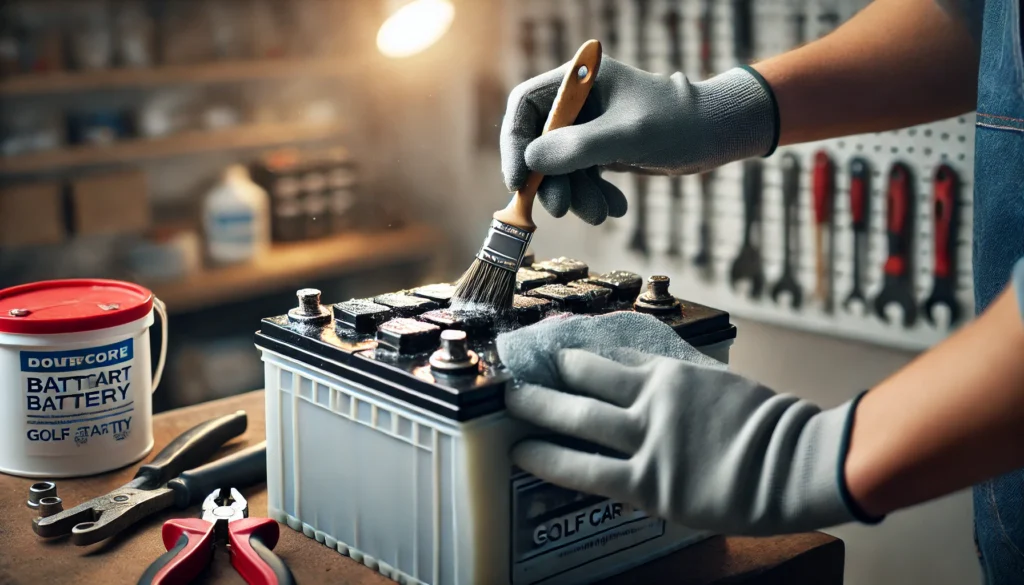Batteries play a crucial role in the performance of a golf cart. Without a healthy battery, you will not get the expected performance from your golf cart. Additionally, your golf cart may suffer from various technical and performance issues like reduced range or even a complete shutdown. The only way to avoid these problems is through disciplined maintenance of your golf cart. Only proper and timely maintenance of your golf cart batteries can ensure the best performance.
Maintaining your golf cart battery regularly offers several benefits, such as:
- Longer lifespan: Well-maintained batteries last longer and save the extra cost of replacing batteries.
- Better performance: Batteries that are in top shape will power your cart more effectively, providing better performance.
- Cost efficiency: As mentioned before, good maintenance of your battery will save you money in the long run by avoiding repair and replacement costs.
Typically, a well-maintained golf cart battery can last between 4-6 years. This depends on several factors such as usage, storage, and maintenance practices. Now, let’s dive into how you can ensure proper and timely maintenance of your golf cart batteries.
Basics of Golf Cart Batteries
Before we dive into maintenance, it’s mandatory for you to know which type of battery you are using. There are mainly two types of batteries used in golf carts:
- Lead-Acid Batteries: These are the most commonly used type of golf cart batteries. They are reliable and cost-effective. However, these batteries require regular maintenance, especially checking the water levels and cleaning the terminals.
- Lithium-Ion Batteries: These batteries are newer in technology, but their popularity is increasing due to their longer lifespan, lighter weight, and faster charging times. These batteries require less maintenance but come at a higher initial cost.
Another factor to consider is the voltage system:
- 36V System: Typically, a 36V system is used in smaller, short-distance golf carts.
- 48V System: This system provides more power and is common in newer golf carts. It’s ideal for longer distances and heavier usage.
Basic Tips for Maintaining Golf Cart Batteries
Taking care of your golf cart batteries is simple and easy. Here, I’m mentioning some easy-to-follow tips and tricks to keep your cart batteries healthy:
- Keep the Battery Terminals Clean and Dry
The battery terminals need to be cleaned and dried regularly. This ensures the right flow of electricity by keeping the conductivity optimal. Dirt and grime can cause corrosion, leading to poor performance. Use a mixture of baking soda and water to clean the terminals. Don’t forget to dry it up before reconnecting the terminals. - Inspect for Corrosion, Leaks, or Cracks
Examine the battery casing for any cracks or leaks. Corrosion on the terminals can also cause issues. If you spot any leaks or cracks, it’s imperative to replace the battery immediately to avoid further damage. - Check the Charge Levels Regularly
Monitoring your battery’s charge levels regularly is important for longevity. Try not to run the cart when the charge is below 20%; rather, recharge it. This helps prevent deep discharges that can harm the battery. - Maintain Water Levels (for Lead-Acid Batteries)
Lead-acid batteries require regular checks of water levels. Use only distilled water to top up the battery cells. It’s important to fill the water just enough to cover the plates. Check water levels every 1-2 weeks to ensure optimal performance.
How to Extend Battery Life with Proper Charging Habits
Charging your golf cart batteries in the right way can significantly extend their lifespan. Here’s what you need to know:
- Avoid Overcharging or Undercharging
Always use the correct, dedicated charger to charge your batteries. Overcharging can cause excessive heat buildup and damage the cells. Undercharging can lead to sulfation and may reduce your battery’s capacity over time. I recommend using an automatic charger that stops charging when the battery is full. - Charge After Every Use
Even if you only use your golf cart for a short time, always recharge the batteries after use.
Proper Charging Duration
Ideally, golf cart batteries should be charged for 8 to 10 hours. This ensures a full charge. Don’t leave your cart plugged in overnight for a complete charge.
Storing Golf Carts During Off-Seasons
If you’re planning to store your golf cart for the winter or any extended period, don’t leave the battery fully discharged or completely charged. Aim for a 50-75% charge level, as this is ideal for long-term storage. Also, store your golf cart in a cool and dry place. If you plan to store it for more than three months, I suggest disconnecting the connections from the terminals.
Common Mistakes to Avoid When Maintaining Golf Cart Batteries
There are a few common mistakes that we often make while maintaining golf carts. Here are some things to watch out for:
- Neglecting Water Levels
Failing to check water levels regularly can cause the battery to dry out. This may lead to irreversible damage. Always top up your lead-acid batteries with distilled water. - Letting Batteries Sit Without Use
If you don’t use your golf cart for an extended period, the battery can suffer from sulfation. Sulfation is a process where lead sulfate crystals build up on the battery plates. This may reduce the battery capacity. Try using a charger with a storage mode to periodically refresh the batteries. - Using Incorrect Chargers
Using a charger that’s not designed for your battery type can cause overcharging or undercharging. Always use the manufacturer-recommended charger for your golf cart’s battery. - Ignoring Physical Damage
Always inspect your battery for any physical damage. Physical damage like cracks or leaks can reduce battery performance.
Signs of a Faulty Golf Cart Battery
It’s important to recognize when your battery is no longer functioning properly. Here are a few signs that your battery may be failing:
- Reduced Runtime or Slow Acceleration
If you notice your golf cart isn’t holding a charge as long as it used to or accelerates slowly, this could indicate that the battery is nearing the end of its lifespan. - Visible Corrosion or Leakage
Corrosion around the terminals or leaking fluid from the battery can be signs that the battery is failing. If you notice either, it’s time to replace the battery as soon as possible.
Battery Won’t Hold a Charge
If your golf cart battery no longer holds a charge, it’s essential to test it with a voltmeter. If the voltage is significantly lower than expected, the battery may need replacing.
How to Replace Golf Cart Batteries: A Step-by-Step Guide
Replacing golf cart batteries can seem daunting, but with the right tools and a little guidance, it’s a manageable task. Here’s a simple step-by-step guide for you:
- Choose the Right Replacement Battery
Make sure the replacement battery matches the required type, voltage, and capacity of your golf cart. Popular brands include Trojan and Powertron. - Safety First
While working, ensure safety first. Don’t forget to disconnect the power, wear protective gloves, and avoid wearing any metal jewelry. - Removing the Old Battery
Remove any cables connected to the old battery, starting with the negative (black) cable, followed by the positive (red) cable. Carefully lift out the old battery. - Installing the New Battery
Place the new battery in the same position. Ensure that the terminals are correctly aligned. Connect the positive terminal first, followed by the negative terminal. Tighten the terminals securely. - Proper Disposal of Old Battery
Old batteries should never be thrown away in the trash. Always recycle them at an authorized facility to ensure they are disposed of properly.

How to Store Golf Cart Batteries for Winter
Winter storage requires extra care to ensure your batteries stay in good condition during the off-season:
- Charge to 50-75%
Store your batteries with around a 50-75% charge to avoid damage during the long winter months. - Disconnect the Battery
Disconnect the battery terminals from the cart to prevent any parasitic drain. - Keep in a Cool and Dry Place
Store the battery in a temperature-controlled environment. Avoid extreme heat or cold.
Advanced Tips to Prolong Battery Life
Here are a few expert-level tips to maximize battery life:
- Equalizing Charge: For lead-acid batteries, an equalizing charge prevents stratification of the acid. This can be done once every 30-60 days.
- Use a Smart Charger: A smart charger with a maintenance mode may help keep the battery in optimal condition by avoiding overcharging.
- Monitor Voltage: Regularly check the battery voltage with a voltmeter to ensure the battery is producing the correct power.
How to Test Golf Cart Batteries
Testing your golf cart battery is crucial to identify any potential issues. Here’s how to do it:
- Step 1: Use a voltmeter to check the battery’s voltage. A healthy 36V system should read around 36V, and a 48V system should read around 48V.
- Step 2: If the reading is significantly lower, it indicates the battery may be failing.
- Step 3: Look for signs of sulfation. It can be identified by checking for white crystals on the plates.
How to Prevent and Identify Battery Sulfation
Sulfation is one of the most common causes of battery failure. To prevent it, follow these tips:
- Charge Regularly: Keep your batteries charged to prevent deep discharge.
- Use a Desulfator: Some chargers have a desulfation feature that helps break down lead sulfate crystals.
- Monitor Battery Voltage: Regularly checking voltage levels can help spot issues before they get too serious.
Conclusion: Keep Your Golf Cart Batteries in Top Condition
By maintaining your battery, it is possible to use it for the expected duration of time. Along with this, it will also save you from costly repairs and replacements. The mentioned tips and tricks will help you enjoy a smooth ride for years to come. Always remember to check water levels before you start, avoid overcharging, and inspect your batteries regularly. With the right care, your golf cart will continue to serve you well.
Frequently Asked Questions (FAQ)
Q: How can I tell if my golf cart battery is fully charged?
A: You can check the charge with a voltmeter. A fully charged 36V system should read 38-42V, while a 48V system should read 50-54V.
Q: How can I prevent my golf cart battery from freezing?
A: Store your battery in a warm place during winter, and keep it charged to prevent freezing.
Q: How should I store my golf cart for 6 months?
A: Store the cart in a cool, dry place with the battery disconnected and charged to 50-75%. Use a maintenance charger if possible.

John kabi
John Kabi is an engineer by profession. He also has very deep experience in the fied of golf and other sports as he himself is a sportsman. He likes to write on various sports gear and review them for others. He his making product review article almost for 10 years.

7 Essential Tips Every Beginner Golfer Should Know
Though it’s not always simple to get started, golf is drawing more new players than ever before. It is normal to feel uncertain about everything

Cut Grey Golf Balls Review 2025: Affordable Performance with Exceptional Value
Golf is one of the most expensive sports, and one of the biggest costs can come from purchasing quality golf balls. With many premium golf

How to Maintain Golf Cart Batteries: Essential Tips for Longevity
Batteries play a crucial role in the performance of a golf cart. Without a healthy battery, you will not get the expected performance from your

Discover the Perfect Balance of Performance and Value: My Experience with WILSON Staff Zip Golf Ball
Selecting the right ball while playing golf is very crucial. It can make a huge difference in your game. As an intermediate golfer, I try

Bozily Golf Rangefinder Review: A Reliable Rangefinder That Surpasses Expectations
Golfers of all levels understand the value of accurate distance measurements. To ensure it, some turn to premium brands like Bushnell or Leupold, and others

Best Rangefinders for Golf Under $100: Affordable Precision for Every Golfer
Finding a reliable and accurate golf rangefinder that meets all your needs for just under $100 can be challenging. Many golfers assume they have to spend hundreds



